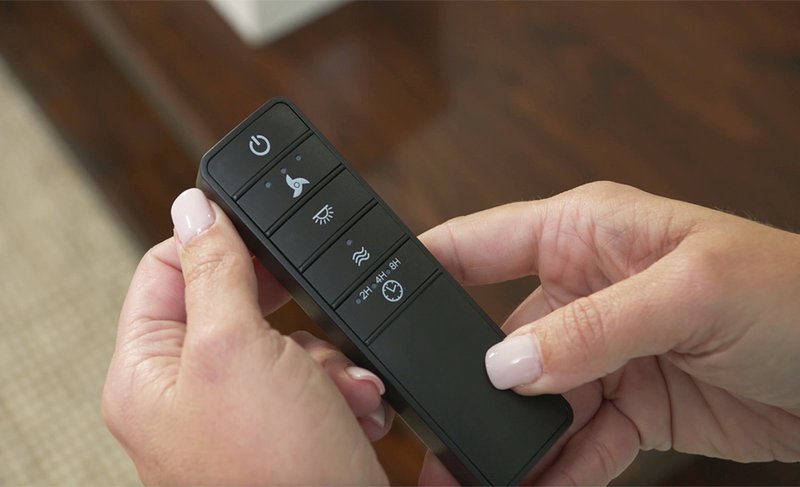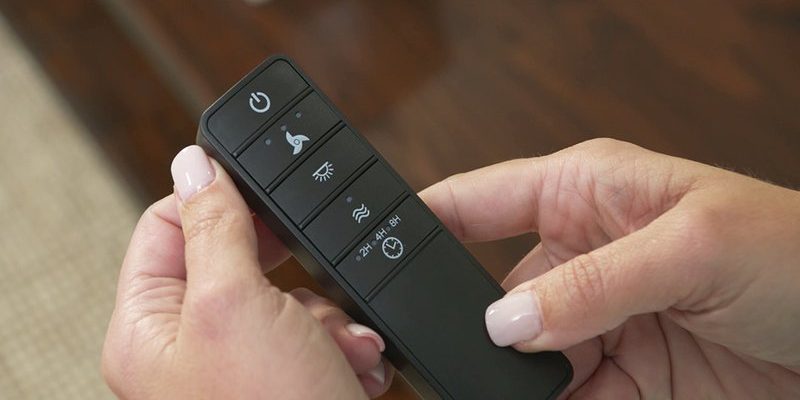
Think of your remote as the “magic wand” for your ceiling fan. When the wand loses its touch, life gets less convenient—suddenly you’re climbing on chairs, fiddling with wall switches, or even (gasp!) using the old pull chains. Honestly, it shouldn’t feel like you’re chasing a runaway puppy to get your ceiling fan to behave. With a little troubleshooting, you can almost always track down the problem and restore that couch-to-fan control.
How Hampton Bay Ceiling Fan Remotes Communicate
Here’s the thing: Hampton Bay ceiling fan remotes use radio frequency (RF) signals—not infrared, like your TV remote. That means there’s no need to point directly at the fan, but it also introduces a few quirks. In RF remotes, the signal travels invisibly through walls and air, but it has a set range (usually around 30 to 50 feet) and can be blocked or scrambled.
These remotes have a little code set (sometimes called DIP switches) inside the battery compartment. This code must match the receiver in the fan. If the codes don’t match—or the signal gets disrupted—the remote feels “dead” or only works when you’re standing right underneath the fan. Sometimes, other wireless devices, neighbor’s fans, or even Wi-Fi routers can scramble things up.
Imagine talking to someone across a crowded, noisy room. Sometimes your words get lost if there’s too much interference or if you’re too far away. The same concept applies here. The good news? Most range issues can be solved without any electronics degree.
Common Causes of Reduced Remote Range
Several everyday issues can cause your Hampton Bay remote to lose range. First, let’s talk batteries. Weak or cheap batteries are like serving lukewarm coffee—sure, it works, but it just isn’t satisfying. When your remote starts to lose its zip, always swap in new, high-quality batteries. Low power means the signal travels a shorter distance or gets noisy.
Next up: interference. Microwaves, Wi-Fi routers, baby monitors, and even some LED lights can flood your home with radio signals that tangle up with your fan remote. You might notice the remote works fine at 10 feet but fizzles out at 20. Try turning off other electronics one by one to see if your range improves.
The third culprit? Physical barriers. Thick walls, mirrors, or even metal furniture can reflect or absorb the RF signal. If you’re sitting in a spot with a lot of obstructions between you and the fan, that could easily explain the weak performance. Sometimes, just shifting your position or rearranging furniture can do the trick.
How to Test and Replace Remote Batteries
Let me explain—batteries might seem like the obvious fix, but you’d be amazed how often they’re the sneaky villain behind remote issues. Hampton Bay remotes usually take two AAA or one 9-volt battery, depending on the model. Pop off the battery cover (sometimes you’ll need a gentle nudge with a thumbnail), and check inside.
Look for these signs of trouble:
- Corrosion or powdery white residue on the terminals
- Loose battery fit
- Batteries sitting in the remote for over a year
Replace with fresh, name-brand batteries (honestly, off-brand ones save pennies but cause headaches). While you’re there, note the little DIP switches or code settings inside the compartment, especially if you plan to re-sync the remote later.
After swapping batteries, test the range by walking slowly away from the fan while pressing each button. If your range jumps back to normal, you’ve found the weakest link. If not, don’t worry—there are more tricks up our sleeve.
Resyncing and Pairing Your Hampton Bay Remote
You might be wondering, “What if the remote and fan aren’t communicating at all?” Sometimes the issue is a lost sync between your remote and the fan’s receiver. This can happen after a power outage or installing new batteries.
Here’s a typical pairing process:
- Turn off the power to the fan at the wall switch or breaker for at least 30 seconds.
- Turn the power back on, and within 30 seconds, press and hold the ‘Sync’ or ‘Learn’ button (usually hidden under the battery cover) on your remote.
- If pairing is successful, you’ll see the fan lights blink or hear a click.
If this doesn’t work, double-check that the DIP switches or code settings on the remote and receiver match exactly. Even one tiny switch in the wrong spot can break the connection.
Some Hampton Bay remotes don’t have an explicit pair button. In that case, try removing and re-inserting the batteries, then pressing multiple buttons (like Fan On/Off or Light On/Off) in rapid succession immediately after restoring power.
Interference: Diagnosing and Reducing Signal Blockers
RF interference is like invisible static in your home’s airwaves. Other remotes, wireless cameras, or even a neighbor’s garage door opener can tangle up your ceiling fan signals.
Start by identifying crowded areas in your home. Is your Wi-Fi router sitting close to the fan receiver? Are there lots of gadgets clustered together in one room? Try turning off these devices one at a time and test the remote’s range after each one. If you notice improvement, you’ve found your culprit.
Another strategy: shift your fan remote’s frequency. On Hampton Bay models with DIP switches, changing the code both on the remote and on the receiver can give you a cleaner, less crowded signal. Just remember to power off the fan at the breaker before poking around in the ceiling fixture (and always use caution—safety first).
Sometimes, even something as simple as a new router or a smart speaker in the same room can cause fresh issues. Don’t underestimate small changes in your daily tech landscape.
Physical Obstructions and Placement Tips
Physical obstacles can seriously reduce the range of your Hampton Bay ceiling fan remote. Picture the RF signal like water from a hose—if you put up a wall, that water isn’t going far. Thick concrete, brick walls, metal shelves, or even certain types of insulation can block or dampen your remote signal.
If your fan is installed in a room with lots of heavy furniture or mirrors (like a home gym with big reflective surfaces), the signal bounces or gets muffled. Changing where you stand makes a bigger difference than you might expect. If you’re always controlling the fan from the same spot and it’s not working, walk to a different corner and try again.
Whenever possible, keep the fan receiver clear of metal objects or wires that could tangle up the signal. And if your remote works in the hallway but not from your favorite chair, consider moving a piece of furniture or tweaking the receiver’s placement in the ceiling canopy.
Resetting the Remote and Receiver
Sometimes, a full reset is the only way to break a stubborn range issue. Like rebooting a frozen computer, resetting both the remote and the fan can clear weird glitches.
Here’s a straightforward reset process:
- Turn off power to the fan at the breaker for at least one full minute.
- Remove the batteries from the remote.
- Restore power to the fan, then immediately replace the remote batteries.
- Press and hold the ‘Learn’ or ‘Sync’ button (if present) for 10 seconds.
This wipes any confusion between old codes or power surges. If you still have no luck, double-check all code switches and connections, and repeat the steps slowly. Patience pays off here—sometimes you need to run through the process twice.
Resetting isn’t magic, but sometimes it feels like it. If all else fails, this step can surprisingly revive a remote that seems totally unresponsive.
When to Replace the Remote or Receiver
If you’ve replaced the batteries, checked the codes, reset everything, and experimented with interference—and the range is still pitiful—there’s a good chance the remote or receiver is failing. Electronics don’t last forever, especially if they’ve taken a tumble, gotten damp, or lived through a few power surges.
Replacement remotes for Hampton Bay ceiling fans are widely available. You can also use a universal ceiling fan remote kit, but be sure it’s compatible with Hampton Bay models. Just keep in mind that universal remotes sometimes require extra setup: syncing codes, matching frequencies, or even swapping out the receiver in the fan’s canopy.
If you choose to replace the receiver inside the fan, always shut off the breaker and double-check wiring diagrams. If wiring isn’t your comfort zone, it’s worth calling an electrician. Safety is the best investment.
Comparing Hampton Bay Remotes to Universal Options
Let’s say you’re thinking, “Should I just get a universal remote and be done with it?” That’s not a bad plan. Universal ceiling fan remotes are designed to work with most major brands, including Hampton Bay. They can be great if your original remote is lost, broken, or discontinued.
Still, matching code settings and ensuring proper pairing is just as important with a universal remote. In my experience, branded remotes are usually a little more “plug and play,” while universal remotes may need a few extra steps—and sometimes don’t play quite as nicely with unique Hampton Bay fan features (like multi-speed dimmers or reverse mode).
If you have a newer fan with smart capabilities, consider looking for remotes that support app control or voice assistants. Technology is moving fast, and today’s universal solutions might surprise you with extra convenience.
Final Thoughts: Getting Your Hampton Bay Remote Back in Range
Chasing down range issues with a Hampton Bay ceiling fan remote can feel like detective work, but it’s almost always fixable. Start with fresh batteries, ensure your remote and receiver codes match, clear out interference, and reset both devices if needed. Sometimes, the solution is as simple as moving a chair or changing a device’s location.
If you’ve worked through each step and still have trouble, replacement parts are easy to find and install—just be sure to match your fan model and code settings. Restoring that “magic wand” feeling is worth a little patience. Next time you settle in to control your fan from across the room, you’ll know exactly what to do if things go wonky. No more chasing stubborn remotes or stretching for dusty pull chains—just smooth, reliable comfort, exactly how it should be.
